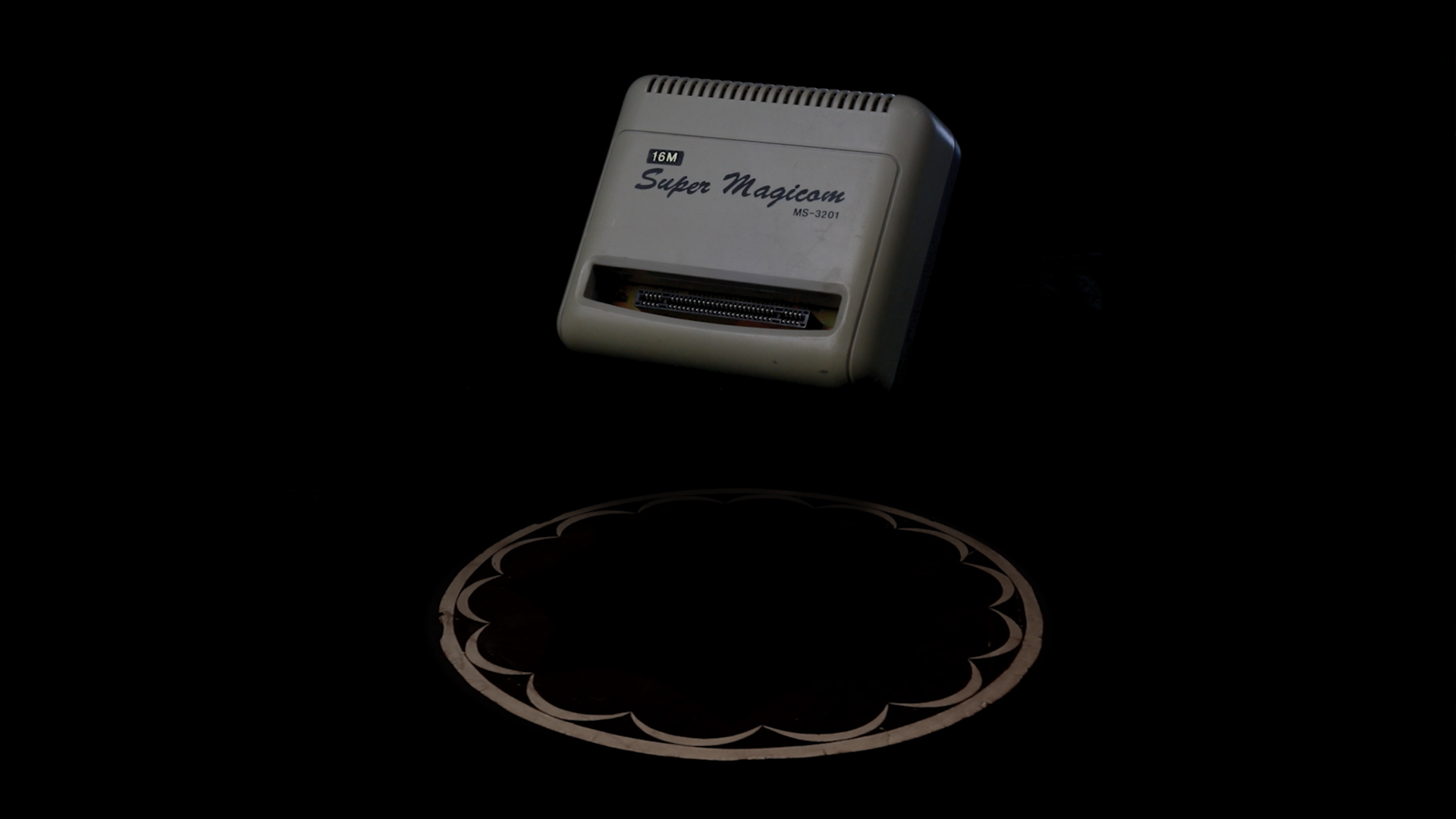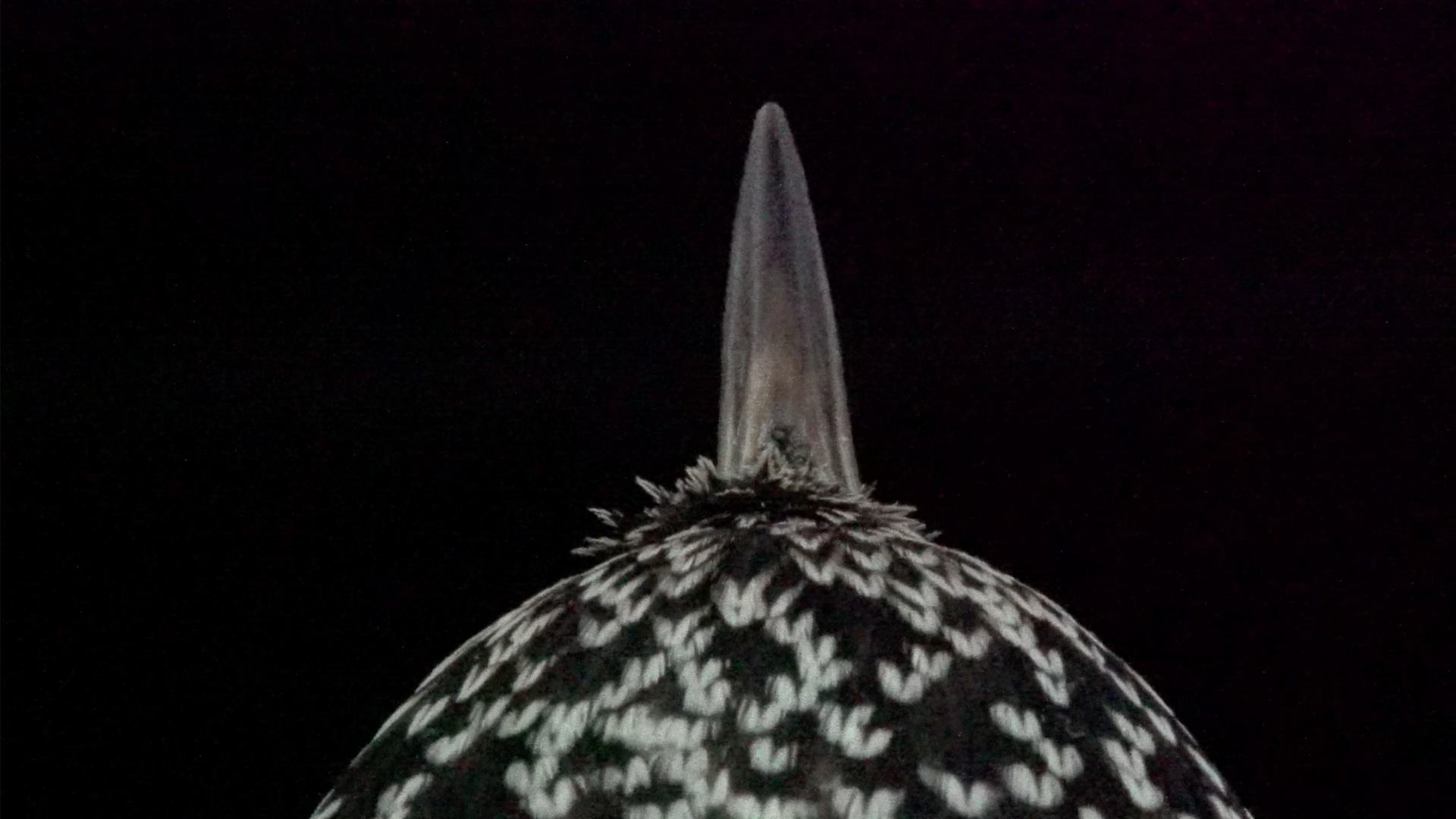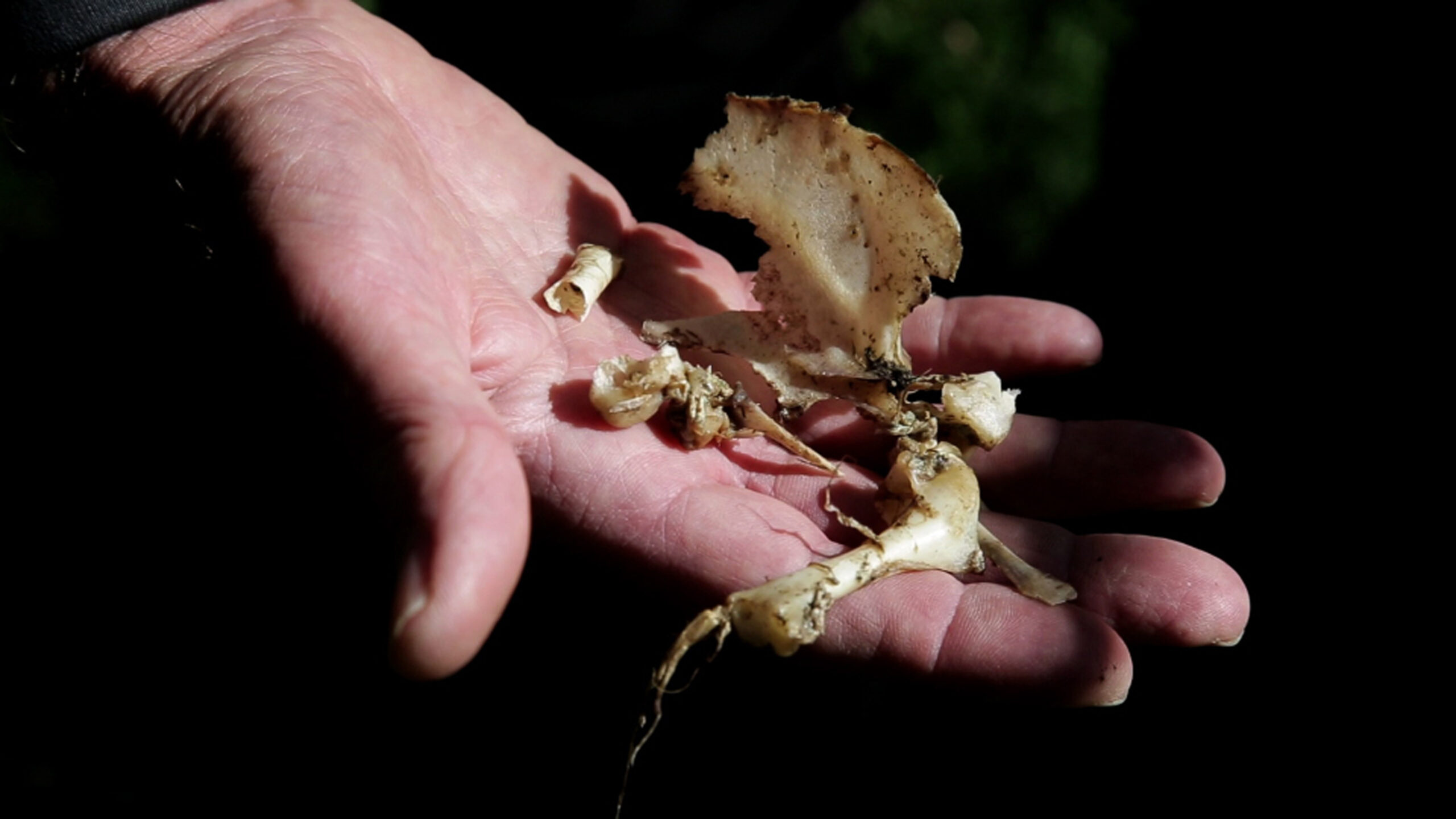Listen to this essay on Soundcloud (12 minute listen)
A series of object appear before us, each accompanied by an almost dissonant, clanging chime:
a golden-wrapped block that is labelled simply, ‘New Zealand Butter’; a rectangle of rose marble; a Roman mask; a Super Magicom games cartridge adapter.
They rotate over a black void, as if floating in space. An Amiga floppy disc hovers over a sand dollar, faint shadows of the other orbiting items playing on their surface.
A green felt cap, then an ancient compass appear in succession, as the sound of a strong wind going by undercuts the scene, punctuated by further chimes and occasional percussive bongs and clangs. It’s an unexpected survey of items that evidently spans millennia: rocks whose smooth, shallow indentations served a purpose at which we can only guess, sitting above bits of plastic and metal that became obsolescent technology only just over two decades earlier.
A museum, with its vitrines, wall hangings and ordered displays, tells a story of knowledge. One that shifts, but often over many years; a timescale that is somewhere between the journalistic and the geologic. Here, it seems, are the archive and objects of a museum, but put instead towards a different story, one that is non-verbal, rhythmic, and cyclical.
About two thirds through Duncan Marquiss’s short video Collision Index (2017), a warm buzzing sound gives way to a quickened pace led by a single, tremolo note, as we see the Super Magicom again, though this time with a speckled pattern of blue flecks projected onto its surface, as if it is moving through an asteroid field. Then a series of rock and pottery fragments arranged into a circle appear and begin to spin around and around, accompanied by an additional burst of repetitive, ascending xylophone notes. Within this mesmeric patterning, the rocks turn swiftly, as if themselves notches on an invisible instrument producing the music we hear unfolding. Brief close-ups elicit further xylophone flourishes that add to the pulses of sound, as we see glimpses of cracked edges, some of the markings of numbers or letters that denote their place in a catalogue or system. But here, they seem oddly liberated, celebrating some unspoken freedom: they multiply, two circles gyrating in parallel, then a growing parade of them cycling by in front of the camera. Arrowheads, bones and pottery begin to crossfade and blur. Until, after an intense minute and a half, the music and visuals give way, releasing us from its hold.

Collision Index, Duncan Marquiss, 2017
Collision Index draws from the collection of the McManus museum in Dundee, but isolates its holdings, rearranges them into an extended music video of sorts. The odds and ends of the collection are stacked, layered, projected onto, and animated: an imposition, as a way to re-animate and re-order those things held within the museum. Though the spinning fragments – a set of uneven triangles, arranged in a circle set for a short, whirling duration; its geometric choreography to a Philip Glass-like soundtrack – set me back to an instructive moment that, in my mind, predates any museum visit. It resonates and reeks, more, of sitting in front of a television as a child, letting its complex arrangements wash over me undifferentiated, where a television meant no more or less than a bit of rock, and a cascade of minimalist composition was no different from singing the alphabet song; a point where you might say there was a levelled array of seeing and feeling, an equivalence of knowings.
In 1901, the Scottish-American steel magnate Andrew Carnegie approached what is now the McManus museum with a proposition to fund the establishment of a set of libraries across Dundee; an offer that he made to thousands of places across Scotland and the US. A decade later, Carnegie established a charitable corporation for such works that is still ongoing – though, notably for our current interests, is its decision in the late 1960s to support the founding of the Children’s Television Workshop, an experimental pedagogical outfit interested in mass media which went on to create shows like The Electric Company and, most prominently, Sesame Street. Embedded within a sketch show, set along the titular street populated by a mixed group of humans and puppets, were a set of short animations that would illustrate numbers or letters. These animations assimilated a familiarity with the advertising format, making use of its quick duration and repetition, but turning it instead to surreal, sensory explorations that prioritised morphing colourful visuals as much as a wide range of sounds: the Pointer Sisters singing a funk count out to the number twelve; Jefferson Airplane’s Grace Slick sing-talking erratically to ten; a sign-language alphabet led by vocalisations by Joan La Barbara; eight bats flying away to the synthesiser sounds of Gershon Kingsley, the geometry of the circle being explored to a soundtrack by Philip Glass. Although obviously an educational format, there was an even-ness and synthesis of the treatment of media that film critic Renata Adler noted in the New Yorker in 1972, when she wrote of Sesame Street that ‘the ideology here, the catechism, the product, is just letters, geometric forms, decency, and numbers.’

Collision Index, Duncan Marquiss, 2017
While the climax of Marquiss’s Collision Index marks a stylistic similarity to such instructional moments, it also asks similar questions: where does our sense of knowing or feeling begin? When did they diverge? How, within the human world we occupy, might we find alternate ways to understand the world beyond that? Collision Index contains many of the elements common to Marquiss’s work, in its levelling of knowledge systems, a questioning of the hierarchies of perception, and the pointed use of sound to highlight these questions. In Sesame Street’s more abstracted moments we can find a melding of music, mathematics, language and aesthetics, what David Kamp in his book Sunny Days (2020) called a ‘gentle psychedelia’, a description that seems apt in its suggestion of perceptual dissolutions and synaesthetic connections. In Marquiss’s work there is a similar syncretic impulse, occupying the documentary form to stage renewed encounters between the supposed knowing of biology or archaeology, alongside the sensing of video and music, to find new equivalences among them.

Evolutionary Jerks & Gradualist Creeps, Duncan Marquiss, 2016
‘We’re a hierarchy of cells and tissues and organ systems, each one of us,’ we hear the evolutionary biologist Niles Eldredge say in Evolutionary Jerks & Gradualist Creeps (2016). The video revolves around two interviews which explore the unlikely overlaps between music and evolutionary theories: Eldredge, who helped popularise the idea of evolution as an uneven process in disparate fits, and who also is an avid collector of cornets; and Armand Marie Leroi, a developmental biologist who has applied evolutionary analysis to the Billboard 100 music charts. Evolutionary Jerks seems to suggest that we might not be entirely hierarchical – both biologists note how culture works not in a top-down or direct ‘tree-like fashion’, but through a network of ‘lateral transfer’. Though a series of quick successions of cuts between conversations and archival evidence, the work places us to consider trilobytes, cornets and George Michael’s ‘Freedom’ (#76 on the 23rd April, 1983) as having developed from similar processes; that identical to genetics it is simply, as Eldredge puts it, ‘the fate of transmissible information’. What emerges is a cross-disciplinary prism of sorts, one that the interviewees acknowledge might not be always accurate – the metaphorical danger in, say, applying fossil evidence to back up economics, or attributing biological traits to politics – but one that provides an elliptically illuminating perspective.

Search Film, Duncan Marquiss, 2015
‘We reach ecstasy by a contestation of knowledge,’ philosopher George Bataille wrote in Inner Experience (1954), a fragmentary and diversionary treatise which explored the ambivalences of knowing and not knowing that motivates human endeavours. While the book is obstinate and evasive, there’s a similar, though quieter, movement here to Marquiss’s videos, which begin with a given structure, and then proceed to question the limits and bases of those structures, using the document of documentary to gesture beyond its factual constraints. A sort of momentary suspension or gentle re-balancing of knowledge systems occurs with the domesticated jackdaw of Mirror Test (2020), who we follow flitting around indoors, upturning the lids of plastic butter tubs, gazing what we might assume as questioningly at the camera, while we hear its co-habitants talk about habit, perception and materialism. In Search Film (2015), an attempt to document the artist’s father’s work as a biologist tracking goshawk populations turns into a meditation on looking, differentiation, and how we interact with the environment. ‘If everybody perceptually took in everything around them, they’d be overwhelmed,’ he states. As we sweep over the details of a pine forest, the film cuts to libraries, shops, internet browser screens, Search Film seems to call for an open and almost vulnerable, child-like state of looking, that then begins to differentiate – a ‘toggling between scales, interrogating the environment’: a body of knowledge that is made through sensing. It is this sort of non-rationalised, muted knowledge that Bataille seems to gesture towards in Inner Experience, when he writes of moving away from a ‘precision of meaning’, towards a dissolution of distances and boundaries. ‘Non-knowledge,’ as Bataille puts it, ‘communicates ecstasy.’ The ‘forgetting of everything’ and ‘insufficiency’ he advocates for are here in Marquiss’s unpicking of assumption and habit, coming from a place of learned constrictions towards a gradual, ecstatic, syncretic release.
Chris Fite-Wassilak is a writer and critic, whose books include Ha-Ha Crystal (Copy Press, 2016) and The Artist in Time (Herbert Press, 2020).








